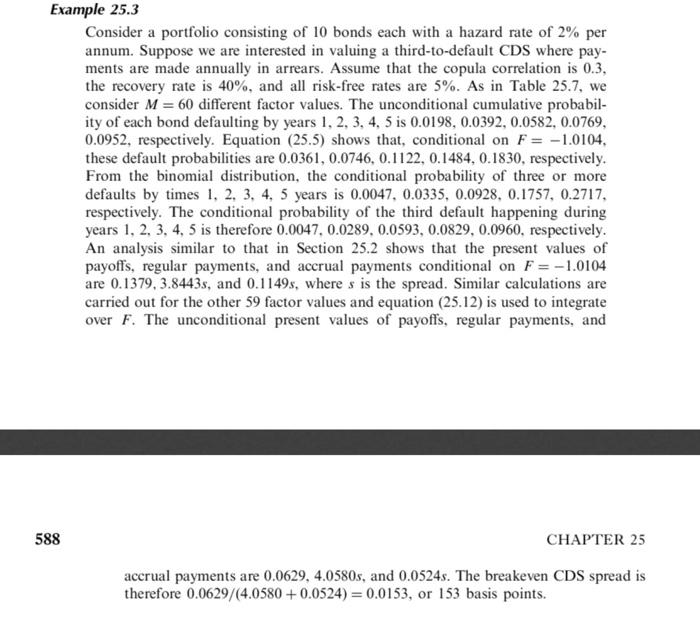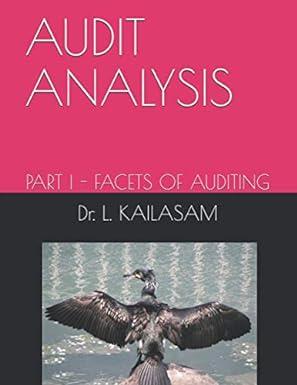be if the credit default spread were 300 basis points instead of 150 basis points?
25.28. In
Example
25.3, wh
In Example 25.3, what is the spread for (a) a first-to-default CDS and (b) a second-to-default CD. Please show working

Example 25.3 Consider a portfolio consisting of 10 bonds each with a hazard rate of 2% per annum. Suppose we are interested in valuing a third-to-default CDS where pay- ments are made annually in arrears. Assume that the copula correlation is 0.3, the recovery rate is 40%, and all risk-free rates are 5%. As in Table 25.7, we consider M = 60 different factor values. The unconditional cumulative probabil- ity of each bond defaulting by years 1, 2, 3, 4, 5 is 0.0198, 0.0392, 0.0582, 0.0769, 0.0952, respectively. Equation (25.5) shows that, conditional on F= -1.0104, these default probabilities are 0.0361, 0.0746, 0.1122, 0.1484, 0.1830, respectively. From the binomial distribution, the conditional probability of three or more defaults by times 1, 2, 3, 4, 5 years is 0.0047, 0.0335, 0.0928, 0.1757, 0.2717, respectively. The conditional probability of the third default happening during years 1, 2, 3, 4, 5 is therefore 0.0047, 0.0289. 0.0593, 0.0829, 0.0960, respectively. An analysis similar to that in Section 25.2 shows that the present values of payoffs, regular payments, and accrual payments conditional on F= -1.0104 are 0.1379, 3.8443s, and 0.1149s, where s is the spread. Similar calculations are carried out for the other 59 factor values and equation (25.12) is used to integrate over F. The unconditional present values of payoffs, regular payments, and 588 CHAPTER 25 accrual payments are 0.0629, 4.0580s, and 0.0524s. The breakeven CDS spread is therefore 0.0629/(4.0580 + 0.0524) = 0.0153, or 153 basis points. Example 25.3 Consider a portfolio consisting of 10 bonds each with a hazard rate of 2% per annum. Suppose we are interested in valuing a third-to-default CDS where pay- ments are made annually in arrears. Assume that the copula correlation is 0.3, the recovery rate is 40%, and all risk-free rates are 5%. As in Table 25.7, we consider M = 60 different factor values. The unconditional cumulative probabil- ity of each bond defaulting by years 1, 2, 3, 4, 5 is 0.0198, 0.0392, 0.0582, 0.0769, 0.0952, respectively. Equation (25.5) shows that, conditional on F= -1.0104, these default probabilities are 0.0361, 0.0746, 0.1122, 0.1484, 0.1830, respectively. From the binomial distribution, the conditional probability of three or more defaults by times 1, 2, 3, 4, 5 years is 0.0047, 0.0335, 0.0928, 0.1757, 0.2717, respectively. The conditional probability of the third default happening during years 1, 2, 3, 4, 5 is therefore 0.0047, 0.0289. 0.0593, 0.0829, 0.0960, respectively. An analysis similar to that in Section 25.2 shows that the present values of payoffs, regular payments, and accrual payments conditional on F= -1.0104 are 0.1379, 3.8443s, and 0.1149s, where s is the spread. Similar calculations are carried out for the other 59 factor values and equation (25.12) is used to integrate over F. The unconditional present values of payoffs, regular payments, and 588 CHAPTER 25 accrual payments are 0.0629, 4.0580s, and 0.0524s. The breakeven CDS spread is therefore 0.0629/(4.0580 + 0.0524) = 0.0153, or 153 basis points







